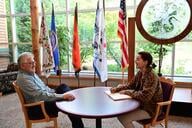You have /5 articles left.
Sign up for a free account or log in.

Istockphoto.com/NicoElNino
While education leaders may be appalled by the closed-border policies coming out of Washington, they often indulge in similar protectionist rhetoric, as highlighted by a recent Wilson Center report.
The language of “national competitiveness” is common in higher education, especially in discussions of China and the U.S. You hear it in contradictory concerns about too many international students (they will take scarce places at elite institutions! They will steal intellectual property!) and too few (our institutions won't keep up if they stop sending students! We need their tuition to stay afloat!).
What these worries have in common is the false premise that education is a race and if we don't hurry others will beat us.
Whereas education competition borrows from the language of economics, an earlier model of educational transfer drew on culture and politics. Transfer was based on importing and exporting from one education system to another. In the 19th and early 20th centuries, American missionaries established colleges across the Middle East and Asia. Philanthropists established international academic exchanges like the Rhodes Scholarship.
While the intentions of these programs were noble, critics rightly argue that transfer often presumed inequality among the peoples and places of origin and destination. They were conceived as part of an outdated project of colonial “civilizing” or geopolitical soft power.
Both competition and transfer are equally insufficient as frameworks for the global education strategy we need for our complex, interconnected world. This autumn, 268 undergraduate students from 27 nations on six continents are pioneering a new “open-source” model as they begin their studies at Duke Kunshan University in China, one of the first liberal arts colleges to be founded in the 21st century.
Duke Kunshan students receive degrees from Duke University and from Duke Kunshan. Duke Kunshan makes academic appointments based on recommendations from the Duke and Duke Kunshan faculties. Duke appoints three members of the seven-member board, including the chair, and all decisions require a supermajority, so an ongoing relationship is built into the governance. Duke Kunshan is a site for experimentation that has the necessary independence -- and the linkages with Duke to ensure iterative mutual learning.
Duke Kunshan is neither a branch campus of Duke nor an "American college in China." It was created through a model different from a religious mission, different from a geopolitical influence campaign and different from a corporate expansion. Instead, Duke Kunshan was built on principles of open source, an approach that comes from technology and has broad implications for complex global collaborations, especially in education.
Open-source software is based on three core principles:
- Source code must be distributed along with the software.
- Anyone may redistribute the software free.
- Anyone may modify the software and derive other software from it, and then distribute those modifications under the same terms.
Collaborative software, governed by nonprofit .org groups organized on these principles, powers the behind-the-scenes infrastructure for almost every technology we rely on, from operating systems (Linux), to web servers (Apache), to databases (MySQL), to programming (Python), to data analysis (Jupyter Notebooks) and machine learning (TensorFlow).
The foundation of open-source collaboration is enlightened self-interest. Participants protect their own interests, but they also recognize that the success of the open-source project will benefit themselves and the commons.
Steven Weber, a political scientist at the University of California, Berkeley, describes how models of open-source governance and collaboration can be extrapolated from technology to other fields. Weber argues that open source is a new way of organizing large-scale human endeavors -- an alternative both to the transactions and contracts of economics and the carrots and sticks of politics.
With Duke Kunshan, founding partners Duke University and Wuhan University built an open-source knowledge project whose benefits flow back and forth across the Pacific. The Duke Kunshan project included “code” contributions from other global university ventures. Academic leaders at Yale-NUS and NYU-Shanghai shared their aspirations and the challenges they’ve faced. They emphasized the importance of a core curriculum in knitting together a global student body and offered their models for us to consider.
So, too, the leaders of Minerva Schools, a bold experiment rethinking higher education around global experiences and learning outcomes, were glad to discuss designs for “far transfer” (students applying concepts to radically different contexts) and other principles underlying their structured approach.
Chinese educators were also committed to the open-source project of Duke Kunshan. Faculty from Wuhan, Tsinghua, Peking, Fudan and other leading Chinese universities convened for workshops and hosted site visits. They helped ensure that the curriculum drew on both classical Chinese tradition and on new experiments in interdisciplinary education that are being incubated at these institutions.
Rather than regard Duke Kunshan as a competitor, these faculty members emphasized the value of engagement with their own efforts.
“China can and should invent its own liberal arts tradition,” one workshop participant wrote. “This invention would be building on the rich traditions of liberal arts education in the West but fits well with the Chinese context and takes advantage of emerging technologies.”
To this we might add that the culture of open source, while derived from technology, is more important (and certainly longer-lasting) than any particular technology.
The way Duke helped prepare the Kunshan faculty for their teaching drew on open-source principles. Duke Kunshan faculty came from universities worldwide, some with years of experience teaching, others fresh out of Ph.D. programs. With a deeply integrated liberal arts curriculum, hybrid interdisciplinary majors, seven-week intensive courses and mandatory externships, Duke Kunshan's model is different from what professors experienced elsewhere. They needed to prepare not just to teach their own courses, but to connect their teaching to the broader educational goals.
What, for instance, did faculty members make of Duke Kunshan’s principle of rooted globalism: “To cultivate informed and engaged citizens who are knowledgeable about each other’s histories, traditions of thought and affiliations, and skilled in navigating among local, national and global identities and commitments”?
And how could debates over this principle engage students in a conversation over the meaning of studying at an institution that is neither Chinese nor American? A cultural anthropologist from China might offer very different answers from a European philosopher of cosmopolitanism.
To ground this discussion, all faculty read John Pomfret’s The Beautiful Country and the Middle Kingdom: America and China, 1776 to the Present, and two Duke Kunshan historians guided faculty through a discussion of the complex and often fraught history of U.S.-China relations.
The integrated and intensive nature of the Duke Kunshan curriculum meant that faculty members could not simply take an existing 14-week course and fold it up, accordion-like, into seven weeks. Instead, they needed to bring together the best of fundamental pedagogical practice already present at Duke (active learning, team-based learning, problem-based learning, student-centered approaches, etc.) with explorations of the more recent and growing body of learning science.
Duke’s learning innovation team partnered with Duke Kunshan to offer an online and residential professional development fellowship in which the founding faculty could design learning experiences from the ground up.
By open sourcing Duke’s faculty development and sharing the “code” freely with Duke Kunshan colleagues, Duke refined approaches for the cross-cultural preparation of faculty that will benefit the community in Durham, N.C. Knowledge will flow between Durham and Kunshan, where Duke lent staff to help establish Duke Kunshan’s Center for Teaching and Learning. Duke faculty rotating through Duke Kunshan will also bring teaching innovations back to Durham. In their third year, Duke Kunshan students will spend time at Duke and share their diverse experiences and global perspective with Duke students.
Open source is how education collaboration should work. Improvements in teaching and learning are positive, not zero, sum. There is no competitive advantage in classroom techniques and strategies to improve student success. If faculty members in China figure out a better way to teach something, open source it.
Their colleagues in America should do the same. We will all reap the benefits when others share their improvements with the community.




